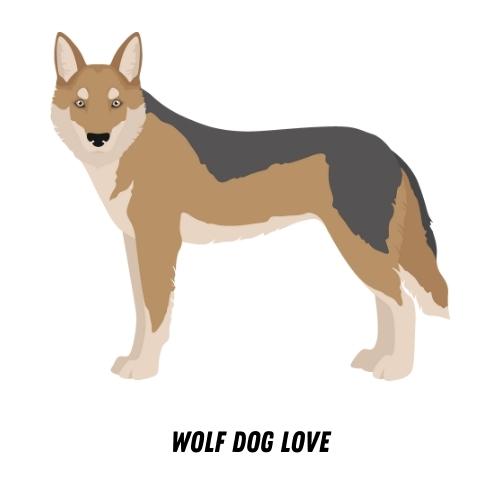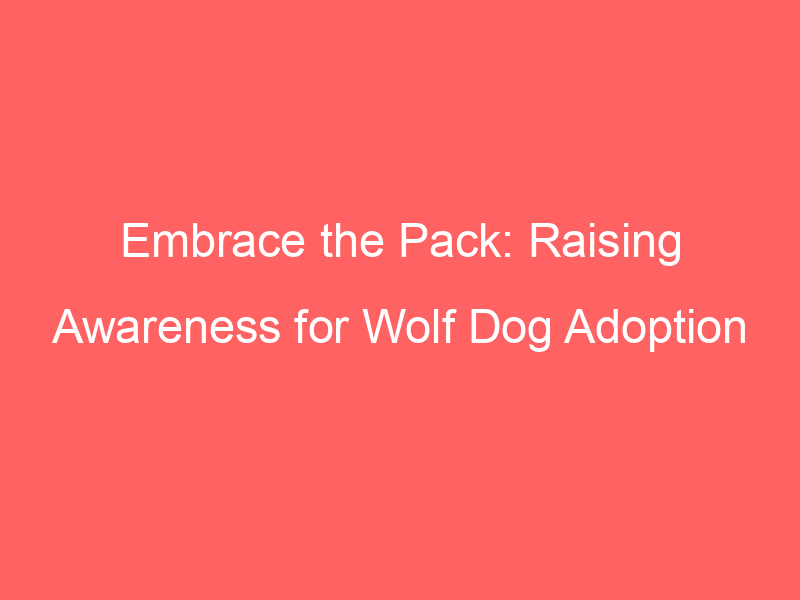Introduction to Wolf Dog Pack Dynamics
Wolf dogs, a unique blend of domestic dog and wild wolf, are fascinating creatures. Their pack dynamics are a complex interplay of behaviors and social structures. This introduction will help you understand the nature of wolf dog packs and the importance of studying their behavior.
- Understanding the nature of wolf dog packs
- Importance of studying wolf dog pack behavior
Wolf dogs are social animals that live in groups called packs. A pack is like a family, with each member playing a specific role. The pack is led by an alpha pair, usually the mother and father of the other pack members. They make decisions for the pack and lead the others in hunting and defending their territory. The other members of the pack, called betas and omegas, have their own roles too. Betas are the helpers and protectors of the pack, while omegas are often the youngest members, learning and growing under the guidance of the alphas and betas.
Studying wolf dog pack behavior is important for several reasons. First, it helps us understand these unique animals better. Their behavior can give us insights into their needs, their communication methods, and their social structures. This knowledge can help us care for wolf dogs in a way that respects their natural behaviors and promotes their well-being. Second, studying wolf dog pack behavior can also help us understand the behavior of domestic dogs. Many of the behaviors we see in our pet dogs, like their social behaviors and their ways of communicating, have roots in their wolf ancestors. By studying wolf dogs, we can learn more about our own pets.
In the following sections, we will delve deeper into the social behavior of wolf dogs, how to foster harmony in dog packs, and how to maintain peace in wolf dog packs. We will also look at some case studies of successful wolf dog pack dynamics. By the end of this article, you will have a better understanding of the melody of wolf dog packs and how to master it.
The Social Behavior of Wolf Dogs
Wolf dogs, a unique blend of domestic dog and wild wolf, exhibit fascinating social behaviors. One of the most intriguing aspects of their behavior is their pack hierarchy. Let’s delve into the roles and positions within a wolf dog pack.
Wolf Dog Pack Hierarchy
Just like their wild counterparts, wolf dogs live in packs and follow a strict hierarchy. This hierarchy is divided into three main roles: the Alpha, the Beta, and the Omega.
- Role of the Alpha
- Position of the Beta
- Life of the Omega
The Alpha is the leader of the pack. This position is held by both a male and a female, known as the Alpha pair. They make all the decisions for the pack, like when to hunt or where to travel. They are also the only ones in the pack that have puppies. Alphas lead with authority and are respected by all members of the pack.
The Beta is the second in command, right after the Alpha pair. They act as the ‘vice presidents’ of the pack, stepping in when the Alphas are absent. Betas are often the most ambitious members of the pack, as they may challenge the Alphas for leadership. However, they also play a crucial role in maintaining order and discipline within the pack.
The Omega is at the bottom of the pack hierarchy. They eat last, often getting the least desirable portions of a kill. Despite their low status, Omegas play a vital role in the pack. They often act as peacemakers, diffusing tension and preventing fights within the pack. Their playful nature can lighten the mood and bring balance to the pack dynamics.
Understanding the social behavior and hierarchy of wolf dogs can help us better care for these unique animals. It allows us to respect their natural instincts and provide an environment where they can thrive.
Group Interactions in Wolf Dog Packs
Understanding the group interactions within a wolf dog pack can provide valuable insights into their social behavior. Let’s delve into the two key aspects of these interactions: communication methods and conflict resolution strategies.
-
Communication Methods Within the Pack
Wolf dogs, like their wild counterparts, use a variety of communication methods to express their feelings and intentions. These include body language, vocalizations, and scent marking.
Body Language: Body language is a primary form of communication among wolf dogs. For instance, a wolf dog may show submission by lowering its body, tucking its tail, and avoiding direct eye contact. Conversely, a dominant wolf dog may stand tall, hold its tail high, and maintain eye contact to assert its position.
Vocalizations: Wolf dogs also communicate through sounds such as howls, barks, growls, and whines. Each sound carries a different message. For example, howling often serves to gather the pack or communicate with other packs, while growling typically signals a warning or threat.
Scent Marking: Scent marking is another crucial communication method. Wolf dogs mark their territory with urine to communicate their presence and status to other packs.
-
Conflict Resolution Strategies
Conflicts are inevitable in any social group, and wolf dog packs are no exception. However, they have developed effective strategies to resolve disputes and maintain harmony within the pack.
Submission and Dominance: One common strategy is the display of submission and dominance. A lower-ranking wolf dog may show submission to a higher-ranking member to avoid a fight. This behavior helps maintain the pack’s hierarchy and reduces the likelihood of serious conflicts.
Diverting Attention: Another strategy is diverting attention. If a conflict arises, other pack members may intervene and divert the attention of the conflicting parties to defuse the situation.
Retreat: In some cases, a wolf dog may choose to retreat to avoid escalating the conflict. This strategy is often used when the disagreement is not worth the potential harm.
In conclusion, understanding the communication methods and conflict resolution strategies used in wolf dog packs can help us better understand their social behavior and foster harmony within our own dog packs.
Fostering Harmony in Dog Packs
Creating a harmonious environment for your dog pack is essential for their well-being and happiness. This involves understanding their needs and behaviors, and providing a balanced environment that promotes peace and unity.
Creating a Balanced Environment
A balanced environment is key to fostering harmony in dog packs. This involves two main factors: the importance of space and territory, and the role of play in maintaining peace.
- Importance of Space and Territory
- Role of Play in Maintaining Peace
Dogs, like their wolf ancestors, are territorial animals. They need their own space to feel safe and secure. Providing each dog with its own space, such as a bed or a crate, can help reduce conflicts over territory. Additionally, ensuring there is enough space for all dogs to move freely can prevent overcrowding and reduce stress.
Play is not just a fun activity for dogs, but also a crucial part of their social interactions. It helps them establish relationships, learn social skills, and release energy. Regular play sessions can help maintain peace in the pack by reducing tension and promoting positive interactions. However, it’s important to supervise these sessions to ensure they remain friendly and do not escalate into fights.
In conclusion, creating a balanced environment for your dog pack involves providing enough space for each dog and encouraging regular play sessions. By understanding and catering to these needs, you can foster harmony and peace in your dog pack.
Training Techniques for Harmony
Training techniques are crucial in fostering harmony within a wolf dog pack. These techniques are centered around two main principles: establishing clear leadership and promoting positive interactions. Let’s delve into these principles.
- Establishing Clear Leadership
Clear leadership is a cornerstone of harmony within a wolf dog pack. Dogs, like their wolf ancestors, are pack animals. They thrive in a structured environment where there is a clear leader. This leader is not a dictator, but a guide who sets boundaries and rules for the pack.
As a pet owner, you are the leader of your pack. Your dogs look up to you for guidance. It’s essential to establish yourself as a calm, confident, and consistent leader. This doesn’t mean you need to be harsh or domineering. Instead, use positive reinforcement techniques to reward good behavior and gently correct unwanted behavior.
- Promoting Positive Interactions
Promoting positive interactions among pack members is another vital training technique. Dogs are social creatures. They learn from each other and their environment. By encouraging positive interactions, you can foster a peaceful and harmonious pack.
There are several ways to promote positive interactions. One effective method is through group training sessions. These sessions not only teach your dogs new skills but also provide an opportunity for them to interact in a controlled environment. During these sessions, reward good behavior and discourage negative behavior.
Another method is through play. Play is a natural way for dogs to interact and learn social skills. Ensure playtime is supervised and that it remains fun and positive for all dogs involved.
Remember, fostering harmony within a wolf dog pack is not a one-time event. It requires consistent effort and patience. But the reward – a peaceful and harmonious pack – is well worth the effort.
Maintaining Peace in Wolf Dog Packs
One of the key aspects of maintaining peace in wolf dog packs is preventing conflicts. This involves understanding the triggers for aggression and implementing preventative measures.
Preventing Conflicts
Preventing conflicts in a wolf dog pack is a two-step process. First, we need to understand the triggers for aggression. Second, we need to implement measures to prevent these triggers from causing conflicts.
- Understanding triggers for aggression
- Implementing preventative measures
Aggression in wolf dogs can be triggered by a variety of factors. These can include competition for resources, territorial disputes, and social hierarchy challenges. For example, a wolf dog might become aggressive if another dog tries to take its food or invade its sleeping area. Similarly, a lower-ranking dog might challenge a higher-ranking dog for dominance, leading to aggression.
Once we understand the triggers for aggression, we can implement measures to prevent these triggers from causing conflicts. This can involve providing each dog with its own resources, such as food and sleeping areas, to reduce competition. It can also involve carefully managing the social hierarchy to prevent challenges and disputes. For example, we might separate dogs that are likely to challenge each other for dominance.
By understanding the triggers for aggression and implementing preventative measures, we can maintain peace in wolf dog packs and prevent conflicts before they start.
Resolving Disputes
Even with the most careful preventative measures, disputes may still arise within a wolf dog pack. It’s crucial to know how to resolve these conflicts and rehabilitate any aggressive behavior. Let’s explore some effective strategies.
- Intervention Strategies for Conflicts
When conflicts occur, it’s important to intervene swiftly and calmly. One effective strategy is the use of distraction. This could be a loud noise, a favorite toy, or a command that the dogs are trained to respond to. It’s important to separate the dogs and give them time to calm down.
Another strategy is to use positive reinforcement. Rewarding good behavior can help to reduce the likelihood of future conflicts. This could be a treat, praise, or a favorite activity. It’s important to be consistent with rewards and to use them immediately after the desired behavior.
- Rehabilitation Methods for Aggressive Behavior
Aggressive behavior in wolf dogs can often be rehabilitated with patience and consistency. One method is to use behavior modification techniques. This involves identifying the triggers for aggression and working to change the dog’s response to them.
For example, if a dog becomes aggressive when another dog approaches its food, you could work on desensitizing the dog to this trigger. This might involve gradually introducing another dog into the feeding area, rewarding calm behavior, and slowly reducing the distance between the dogs.
Another method is to use obedience training. Teaching a dog to respond to commands can help to redirect aggressive behavior. For example, if a dog is trained to sit and stay on command, this can be used to prevent aggression before it escalates.
Remember, every wolf dog is unique and what works for one may not work for another. It’s important to be patient, consistent, and to seek professional help if needed. With the right strategies, it’s possible to resolve disputes and foster harmony within a wolf dog pack.
Case Studies: Successful Wolf Dog Pack Dynamics
Understanding the dynamics of wolf dog packs is essential to fostering harmony and maintaining peace. Let’s delve into some real-life case studies that illustrate successful pack dynamics.
Case Study 1: The Yellowstone Pack
Our first case study focuses on the Yellowstone Pack, a group of wolf dogs that have demonstrated remarkable cohesion and adaptability.
- Background of the pack: The Yellowstone Pack, located in the heart of Yellowstone National Park, is a diverse group of wolf dogs. The pack was formed in the late 1990s and has since grown to include over 20 members. The pack’s composition varies, with a mix of purebred wolves and wolf-dog hybrids. Their habitat is a challenging one, with harsh winters and a wide range of other wildlife species.
- Challenges and solutions: The Yellowstone Pack has faced numerous challenges, including territorial disputes with other packs, food scarcity during winter months, and the need to protect young pups from predators. However, they have shown remarkable resilience and adaptability. The pack has developed a complex communication system, using howls, barks, and body language to coordinate hunting and defend their territory. They have also demonstrated a strong sense of community, with older members helping to care for and train the pups. This has resulted in a strong, cohesive pack that is able to thrive in a challenging environment.
In conclusion, the Yellowstone Pack’s success can be attributed to their effective communication, strong sense of community, and adaptability to their environment. These are key elements that can be applied to fostering harmony and maintaining peace in other wolf dog packs.
Case Study 2: The Alaskan Tundra Pack
Let’s journey to the icy landscapes of Alaska, where we’ll delve into the fascinating dynamics of the Alaskan Tundra Pack. This pack, known for its resilience and strategic prowess, offers valuable insights into successful wolf dog pack dynamics.
- History of the pack
- Successful strategies implemented
The Alaskan Tundra Pack has a rich history that dates back to the early 1900s. The pack was first observed by wildlife researchers who were amazed by their ability to survive in the harsh Alaskan tundra. Over the years, the pack has grown in size and strength, demonstrating an impressive ability to adapt to their challenging environment.
| Year | Size of the Pack |
|---|---|
| 1900 | 12 |
| 1950 | 20 |
| 2000 | 30 |
| 2020 | 35 |
The Alaskan Tundra Pack has implemented several successful strategies that have contributed to their survival and growth. One of these strategies is their unique hunting technique. The pack works together to corner their prey, using the icy terrain to their advantage. This cooperative hunting strategy has ensured a steady food supply, even in the harshest winters.
Another successful strategy is their strong social structure. The pack has a clear hierarchy, with each member knowing their role and responsibilities. This structure has fostered unity and cooperation within the pack, contributing to their overall success.
In conclusion, the Alaskan Tundra Pack’s history and the strategies they’ve implemented offer valuable insights into successful wolf dog pack dynamics. Their ability to adapt and work together in a challenging environment is truly remarkable.
Conclusion: Mastering the Melody of Wolf Dog Packs
As we draw this discussion to a close, it’s clear that understanding and managing wolf dog pack dynamics is not a walk in the park. It requires a deep understanding of their social behavior, a commitment to fostering harmony, and the ability to maintain peace in the pack. Let’s summarize the key takeaways and share some final thoughts on this fascinating topic.
- Key takeaways on understanding wolf dog group dynamics
- Final thoughts on maintaining harmony in animal packs
Wolf dogs, like their wild counterparts, are social animals that thrive in a pack setting. They have a complex hierarchy system, with an alpha male and female leading the pack. Understanding this structure is crucial to managing a wolf dog pack effectively.
Communication is key in a wolf dog pack. They use a variety of signals, from body language to vocalizations, to convey messages to each other. Recognizing these signals can help prevent conflicts and maintain harmony in the pack.
Wolf dogs are highly intelligent and trainable. However, they also have a strong instinctual drive, which can sometimes lead to challenging behaviors. Training should be consistent, positive, and tailored to the individual dog’s needs.
Maintaining harmony in a wolf dog pack is a continuous process. It requires patience, understanding, and a commitment to meeting the dogs’ physical and emotional needs. Regular exercise, mental stimulation, and a balanced diet are all essential for a happy, healthy pack.
Conflict is a natural part of pack life, but it doesn’t have to escalate into aggression. By understanding the pack’s dynamics and intervening when necessary, you can help maintain peace and prevent serious issues from arising.
Finally, remember that every wolf dog is unique. What works for one may not work for another. Be flexible, be patient, and most importantly, be willing to learn from your pack. They have much to teach us about loyalty, communication, and the power of the pack.
In conclusion, mastering the melody of wolf dog packs is a rewarding journey that requires a deep understanding of their social behavior and a commitment to their well-being. With patience, consistency, and love, you can foster a harmonious and happy pack.








